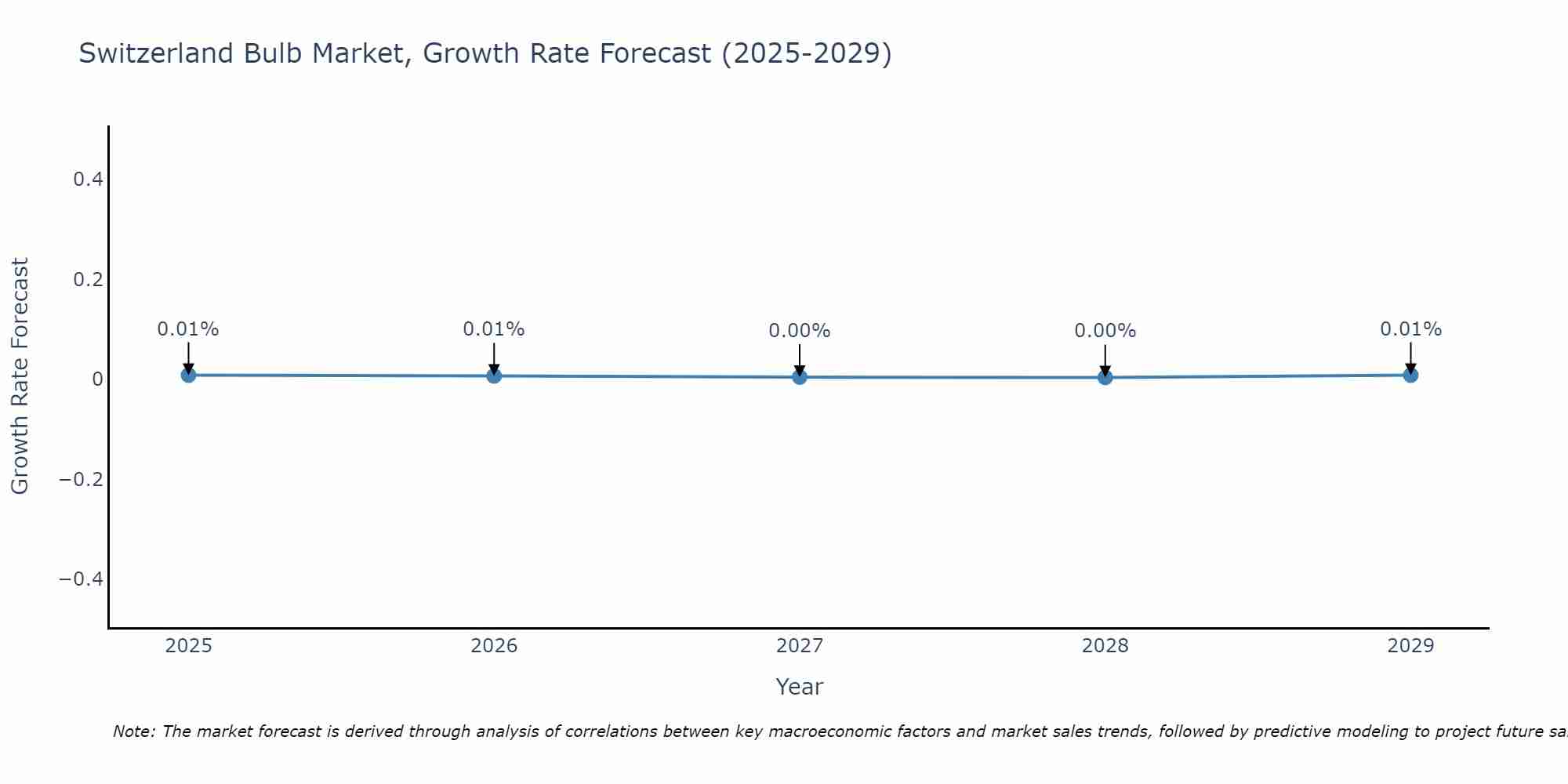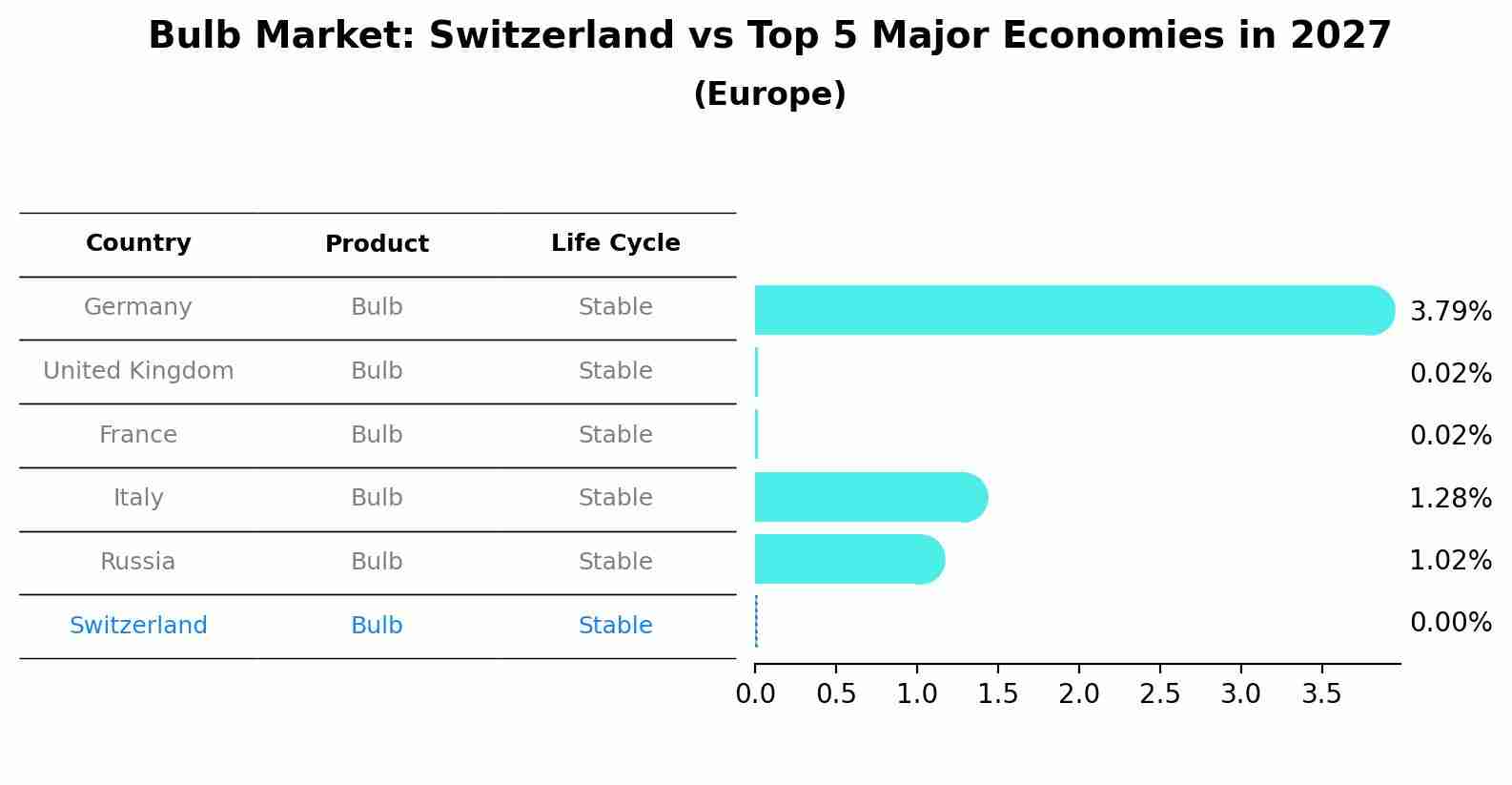Switzerland Bulb Market (2025-2031) | Companies, Outlook, Size, Trends, Growth, Industry, Value, Segmentation, Revenue, Analysis, Forecast & Share
| Product Code: ETC5110900 | Publication Date: Nov 2023 | Updated Date: Aug 2025 | Product Type: Market Research Report | |
| Publisher: 6Wresearch | Author: Sachin Kumar Rai | No. of Pages: 60 | No. of Figures: 30 | No. of Tables: 5 |
Switzerland Bulb Market Size Growth Rate
The Switzerland Bulb Market is projected to witness mixed growth rate patterns during 2025 to 2029. Although the growth rate starts strong at 0.01% in 2025, it steadily loses momentum, ending at 0.01% by 2029.

Bulb Market: Switzerland vs Top 5 Major Economies in 2027 (Europe)
Switzerland's Bulb market is anticipated to experience a stable growth rate of 0.00% by 2027, reflecting trends observed in the largest economy Germany, followed by United Kingdom, France, Italy and Russia.

Switzerland Bulb Market Overview
The bulb market in Switzerland is transitioning toward energy-efficient lighting solutions as consumers become more environmentally conscious. With the phase-out of incandescent bulbs, LED technology has gained popularity due to its longevity and reduced energy consumption. This shift is supported by government incentives and initiatives aimed at promoting energy-efficient lighting solutions across residential, commercial, and industrial sectors. Moreover, innovations in smart lighting technologies, which offer enhanced control and customization, are driving further growth in the market. The demand for decorative and specialty bulbs is also rising, reflecting changing consumer preferences for aesthetics alongside functionality.
Drivers of the market
In the Swiss bulb market, the shift towards energy-efficient lighting solutions is a major driver. Consumers and businesses are increasingly adopting LED bulbs due to their longer lifespan and lower energy consumption compared to traditional incandescent bulbs. Government initiatives promoting energy efficiency and sustainability are also encouraging the replacement of outdated lighting technologies with modern, eco-friendly alternatives, thereby boosting the market for bulbs.
Challenges of the market
The bulb market in Switzerland faces declining demand for traditional incandescent bulbs due to the increasing shift towards energy-efficient lighting solutions like LEDs. This transition has forced manufacturers to pivot their production lines, which requires significant investment. Moreover, the market is heavily regulated, particularly in terms of energy consumption standards, which can be a barrier for manufacturers of less-efficient products. Competition from international brands and cheaper imports also challenges domestic producers.
Government Policy of the market
Government regulations on energy efficiency and environmental sustainability directly affect the bulb market in Switzerland. Policies have phased out traditional incandescent bulbs in favor of energy-saving alternatives like LED and CFL bulbs. Swiss energy policies align with EU regulations, promoting the use of energy-efficient lighting solutions through tax incentives, rebates, and strict standards on energy consumption and product labeling.
Key Highlights of the Report:
- Switzerland Bulb Market Outlook
- Market Size of Switzerland Bulb Market, 2024
- Forecast of Switzerland Bulb Market, 2031
- Historical Data and Forecast of Switzerland Bulb Revenues & Volume for the Period 2021-2031
- Switzerland Bulb Market Trend Evolution
- Switzerland Bulb Market Drivers and Challenges
- Switzerland Bulb Price Trends
- Switzerland Bulb Porter`s Five Forces
- Switzerland Bulb Industry Life Cycle
- Historical Data and Forecast of Switzerland Bulb Market Revenues & Volume By Type for the Period 2021-2031
- Historical Data and Forecast of Switzerland Bulb Market Revenues & Volume By Incandescent Bulbs for the Period 2021-2031
- Historical Data and Forecast of Switzerland Bulb Market Revenues & Volume By Fluorescent Bulbs for the Period 2021-2031
- Historical Data and Forecast of Switzerland Bulb Market Revenues & Volume By CFLs for the Period 2021-2031
- Historical Data and Forecast of Switzerland Bulb Market Revenues & Volume By Halogens for the Period 2021-2031
- Historical Data and Forecast of Switzerland Bulb Market Revenues & Volume By LEDs for the Period 2021-2031
- Historical Data and Forecast of Switzerland Bulb Market Revenues & Volume By Application for the Period 2021-2031
- Historical Data and Forecast of Switzerland Bulb Market Revenues & Volume By Lamps & Light Bulbs for the Period 2021-2031
- Historical Data and Forecast of Switzerland Bulb Market Revenues & Volume By Operation Theatre (OT Instruments) for the Period 2021-2031
- Historical Data and Forecast of Switzerland Bulb Market Revenues & Volume By Torchlights and Flashlights for the Period 2021-2031
- Historical Data and Forecast of Switzerland Bulb Market Revenues & Volume By Automobile Headlights for the Period 2021-2031
- Historical Data and Forecast of Switzerland Bulb Market Revenues & Volume By Mining Headgears for the Period 2021-2031
- Historical Data and Forecast of Switzerland Bulb Market Revenues & Volume By Others for the Period 2021-2031
- Switzerland Bulb Import Export Trade Statistics
- Market Opportunity Assessment By Type
- Market Opportunity Assessment By Application
- Switzerland Bulb Top Companies Market Share
- Switzerland Bulb Competitive Benchmarking By Technical and Operational Parameters
- Switzerland Bulb Company Profiles
- Switzerland Bulb Key Strategic Recommendations
Frequently Asked Questions About the Market Study (FAQs):
1 Executive Summary |
2 Introduction |
2.1 Key Highlights of the Report |
2.2 Report Description |
2.3 Market Scope & Segmentation |
2.4 Research Methodology |
2.5 Assumptions |
3 Switzerland Bulb Market Overview |
3.1 Switzerland Country Macro Economic Indicators |
3.2 Switzerland Bulb Market Revenues & Volume, 2021 & 2031F |
3.3 Switzerland Bulb Market - Industry Life Cycle |
3.4 Switzerland Bulb Market - Porter's Five Forces |
3.5 Switzerland Bulb Market Revenues & Volume Share, By Type, 2021 & 2031F |
3.6 Switzerland Bulb Market Revenues & Volume Share, By Application, 2021 & 2031F |
4 Switzerland Bulb Market Dynamics |
4.1 Impact Analysis |
4.2 Market Drivers |
4.2.1 Growing demand for energy-efficient lighting solutions |
4.2.2 Government initiatives promoting the use of eco-friendly bulbs |
4.2.3 Technological advancements leading to innovative bulb designs and features |
4.3 Market Restraints |
4.3.1 High initial cost of purchasing energy-efficient bulbs |
4.3.2 Competition from alternative lighting solutions like LED strips |
4.3.3 Limited consumer awareness about the benefits of using energy-efficient bulbs |
5 Switzerland Bulb Market Trends |
6 Switzerland Bulb Market Segmentations |
6.1 Switzerland Bulb Market, By Type |
6.1.1 Overview and Analysis |
6.1.2 Switzerland Bulb Market Revenues & Volume, By Incandescent Bulbs, 2021-2031F |
6.1.3 Switzerland Bulb Market Revenues & Volume, By Fluorescent Bulbs, 2021-2031F |
6.1.4 Switzerland Bulb Market Revenues & Volume, By CFLs, 2021-2031F |
6.1.5 Switzerland Bulb Market Revenues & Volume, By Halogens, 2021-2031F |
6.1.6 Switzerland Bulb Market Revenues & Volume, By LEDs, 2021-2031F |
6.2 Switzerland Bulb Market, By Application |
6.2.1 Overview and Analysis |
6.2.2 Switzerland Bulb Market Revenues & Volume, By Lamps & Light Bulbs, 2021-2031F |
6.2.3 Switzerland Bulb Market Revenues & Volume, By Operation Theatre (OT Instruments), 2021-2031F |
6.2.4 Switzerland Bulb Market Revenues & Volume, By Torchlights and Flashlights, 2021-2031F |
6.2.5 Switzerland Bulb Market Revenues & Volume, By Automobile Headlights, 2021-2031F |
6.2.6 Switzerland Bulb Market Revenues & Volume, By Mining Headgears, 2021-2031F |
6.2.7 Switzerland Bulb Market Revenues & Volume, By Others, 2021-2031F |
7 Switzerland Bulb Market Import-Export Trade Statistics |
7.1 Switzerland Bulb Market Export to Major Countries |
7.2 Switzerland Bulb Market Imports from Major Countries |
8 Switzerland Bulb Market Key Performance Indicators |
8.1 Average lifespan of bulbs in the market |
8.2 Adoption rate of energy-efficient bulbs among households |
8.3 Percentage of total energy savings achieved by using energy-efficient bulbs |
9 Switzerland Bulb Market - Opportunity Assessment |
9.1 Switzerland Bulb Market Opportunity Assessment, By Type, 2021 & 2031F |
9.2 Switzerland Bulb Market Opportunity Assessment, By Application, 2021 & 2031F |
10 Switzerland Bulb Market - Competitive Landscape |
10.1 Switzerland Bulb Market Revenue Share, By Companies, 2024 |
10.2 Switzerland Bulb Market Competitive Benchmarking, By Operating and Technical Parameters |
11 Company Profiles |
12 Recommendations | 13 Disclaimer |
- Single User License$ 1,995
- Department License$ 2,400
- Site License$ 3,120
- Global License$ 3,795
Search
Related Reports
- Portugal Electronic Document Management Market (2025-2031) | Strategy, Consumer Insights, Analysis, Investment Trends, Opportunities, Growth, Size, Share, Industry, Revenue, Segments, Value, Segmentation, Supply, Forecast, Restraints, Outlook, Competition, Drivers, Trends, Demand, Pricing Analysis, Competitive, Strategic Insights, Companies, Challenges
- France Electronic Document Management Market (2025-2031) | Strategy, Consumer Insights, Analysis, Investment Trends, Opportunities, Growth, Size, Share, Industry, Revenue, Segments, Value, Segmentation, Supply, Forecast, Restraints, Outlook, Competition, Drivers, Trends, Demand, Pricing Analysis, Competitive, Strategic Insights, Companies, Challenges
- Portugal Occupational Health & Safety Services Market (2025-2031) | Strategy, Consumer Insights, Analysis, Investment Trends, Opportunities, Growth, Size, Share, Industry, Revenue, Segments, Value, Segmentation, Supply, Forecast, Restraints, Outlook, Competition, Drivers, Trends, Demand, Pricing Analysis, Competitive, Strategic Insights, Companies, Challenges
- Netherlands Occupational Health and Safety Services Market (2025-2031) | Strategy, Consumer Insights, Analysis, Investment Trends, Opportunities, Growth, Size, Share, Industry, Revenue, Segments, Value, Segmentation, Supply, Forecast, Restraints, Outlook, Competition, Drivers, Trends, Demand, Pricing Analysis, Competitive, Strategic Insights, Companies, Challenges
- Belgium and Luxembourg Facility Management Market (2025-2031) | Strategy, Consumer Insights, Analysis, Investment Trends, Opportunities, Growth, Size, Share, Industry, Revenue, Segments, Value, Segmentation, Supply, Forecast, Restraints, Outlook, Competition, Drivers, Trends, Demand, Pricing Analysis, Competitive, Strategic Insights, Companies, Challenges
- Russia Women Intimate Apparel Market (2025-2031) | Strategy, Consumer Insights, Analysis, Investment Trends, Opportunities, Growth, Size, Share, Industry, Revenue, Segments, Value, Segmentation, Supply, Forecast, Restraints, Outlook, Competition, Drivers, Trends, Demand, Pricing Analysis, Competitive, Strategic Insights, Companies, Challenges
- Africa Chocolate Market (2025-2031) | Size, Share, Trends, Growth, Revenue, Analysis, Forecast, industry & Outlook
- Global Hydroxychloroquine And Chloroquine Market (2025-2031) | Industry, Trends, Size, Outlook, Growth, Value, Companies, Revenue, Analysis, Share, Forecast
- Saudi Arabia Plant Maintenance Market (2025-2031) | Industry, Size, Growth, Revenue, Value, Companies, Forecast, Analysis, Share & Trends
- Taiwan Electric Truck Market (2025-2031) | Outlook, Industry, Revenue, Size, Forecast, Growth, Analysis, Share, Companies, Value & Trends
Industry Events and Analyst Meet
Our Clients
Whitepaper
- Middle East & Africa Commercial Security Market Click here to view more.
- Middle East & Africa Fire Safety Systems & Equipment Market Click here to view more.
- GCC Drone Market Click here to view more.
- Middle East Lighting Fixture Market Click here to view more.
- GCC Physical & Perimeter Security Market Click here to view more.
6WResearch In News
- Doha a strategic location for EV manufacturing hub: IPA Qatar
- Demand for luxury TVs surging in the GCC, says Samsung
- Empowering Growth: The Thriving Journey of Bangladesh’s Cable Industry
- Demand for luxury TVs surging in the GCC, says Samsung
- Video call with a traditional healer? Once unthinkable, it’s now common in South Africa
- Intelligent Buildings To Smooth GCC’s Path To Net Zero













